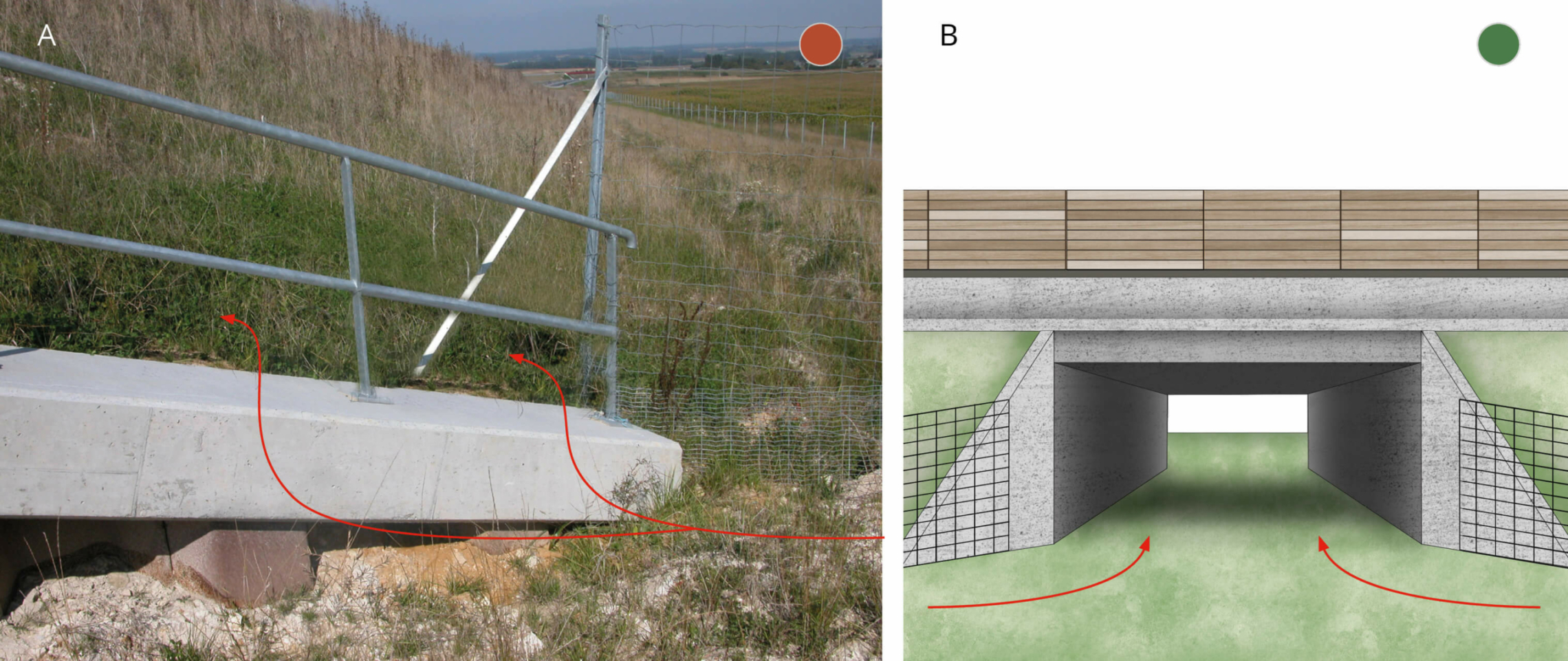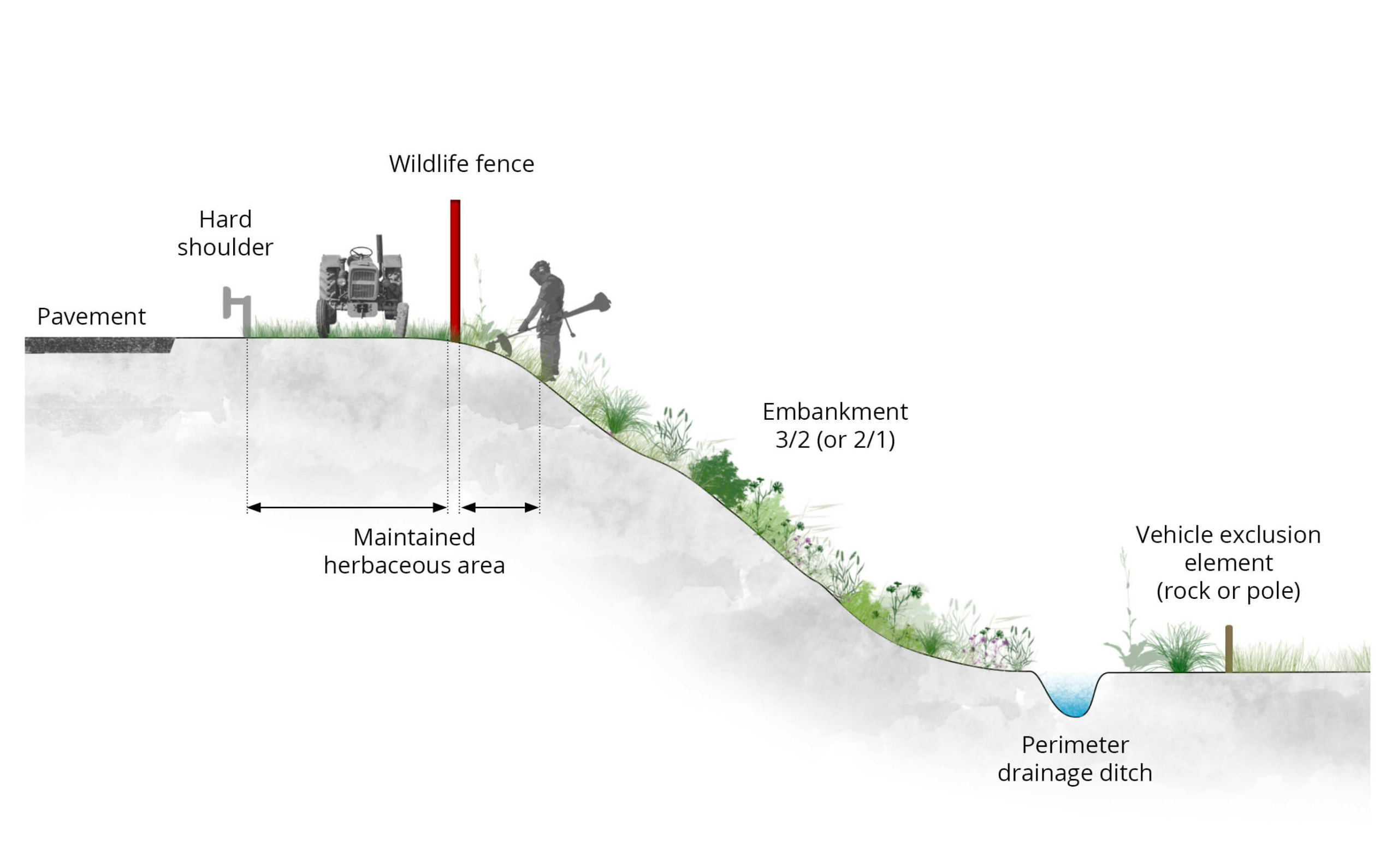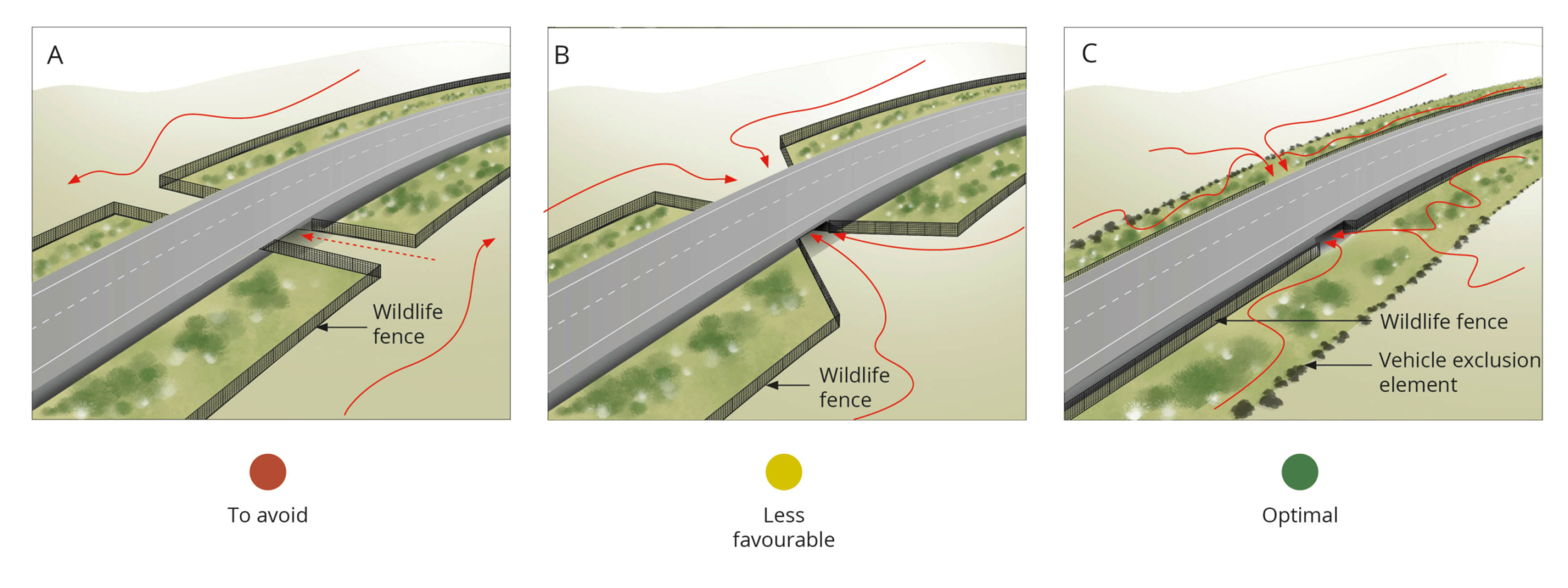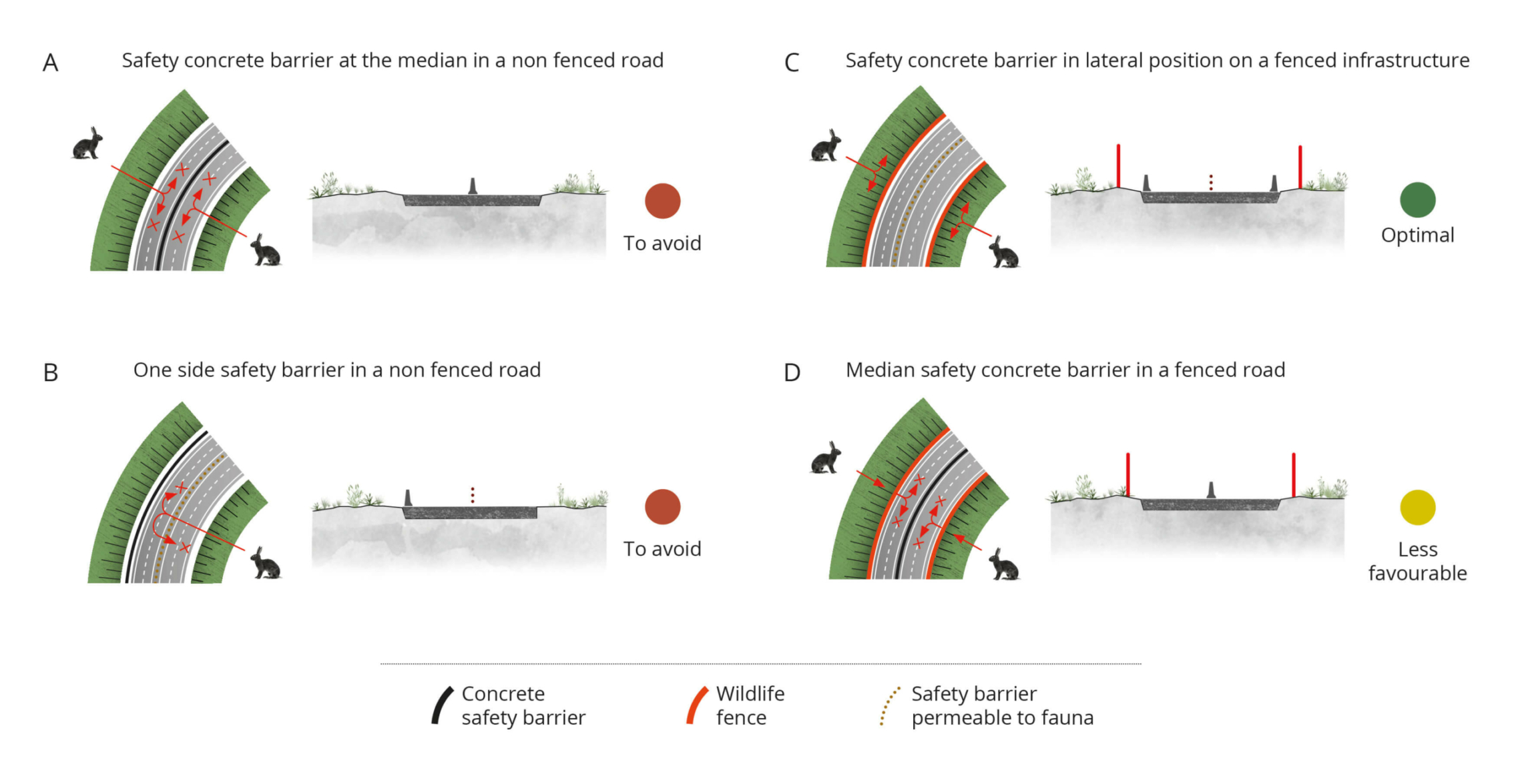In general, wildlife fences should be installed only where there is a high risk of accidents involving wildlife or hotspots of wildlife mortality. In many countries, perimeter fences are an obligatory safety measure along high-speed railways, motorways and other busy roads. Local regulations may also govern the use and features of fencing.
On roads with relatively low-traffic intensity, fences should be avoided or installed only in sections of particular traffic safety concern or high wildlife mortality. Extensive and unnecessary fencing imposes a barrier that, over time, could be a bigger threat to wildlife populations than traffic mortality. Other solutions to reduce wildlife-vehicle collisions such as driver warning devices and wildlife deterrents may be more appropriate in low traffic roads or railways (see Section 5.3 – Driver warnings and Section 5.4 – Wildlife deterrents).
A threshold traffic intensity below which fencing is not recommended must be established according to local conditions and studies. In some Nordic countries fencing is only considered at a threshold of over 4,000 vehicles per day while in many central and southern European countries the recommended threshold is 10,000 vehicles per day
Fences should always be installed on both sides of roads or rail tracks in order to prevent wildlife accessing the infrastructure, becoming trapped there or being forced to return to the carriageway.
Fences should always be well attached to the entrances of any transversal structure (at the walls on underpasses, lateral barriers or screens on overpasses, Figure 5.2.2) to prevent animals accessing the road or rail track. Instead, fences should funnel animals towards suitable wildlife crossing structures.
The length of fences should be as short as possible but as long as needed to terminate fences securely, preferably at crossing structures. Fence ends must be given special attention as they are potential entry points for wildlife to access the carriageway.
Fence openings to connect local access roads or trails, can provide unwanted and dangerous entry points for wildlife. They must be secured to prevent animals from entering the fenced carriageway. This can be achieved by gates, cattle grids or extending the fence along the minor road and may require a cooperative process between several infrastructure operators.
Fences will never guarantee complete traffic safety. Occasionally, animals will succeed in entering the carriageway and be trapped in the fenced corridor, or use the verges as permanent or occasional habitats. These animals, particularly large mammals, are a severe safety hazard as they may behave erratically and unpredictably and because drivers do not expect animals within the secured carriageway. So, the installation of escape facilities (jump out, one-way gates or other) could be necessary near openings or fence ends (see Section 5.2.7 – Escape devices).
At interchanges, specific solutions must be defined according to site features. Fencing may continue along access and exit routes to reduce the possibility of wildlife entering infrastructure (see an example at Figure 5.2.3A). Alternatively, fencing could be limited to the main infrastructure, with openings only for access and exit routes while local roads with low traffic may be adapted, combining road and wildlife crossings at both sides. Installing cattle grids at entry and exit routes, when local conditions and regulations permit it, could also help to prevent wildlife accessing the fenced road (Figure 5.2.3B).
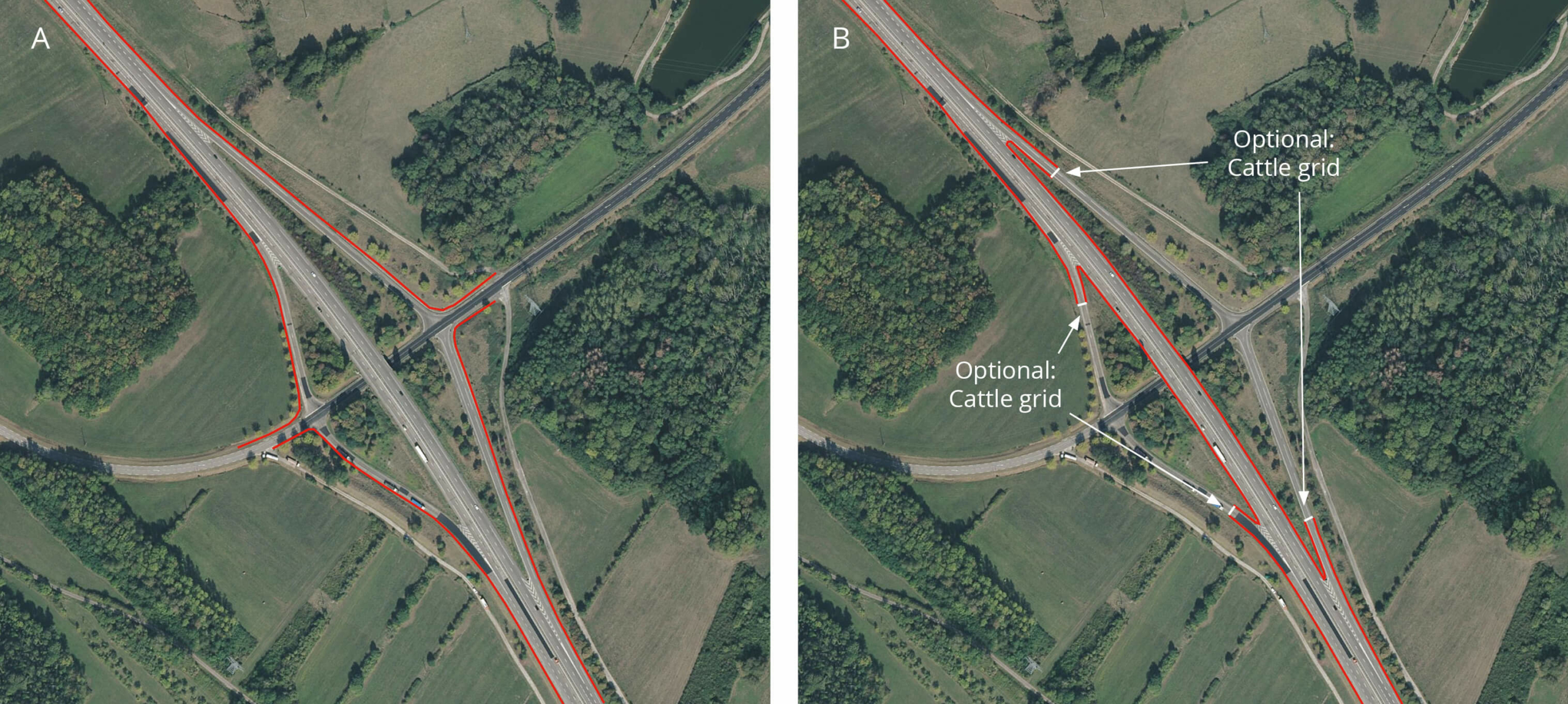
In order to ensure the maximum available habitats and lateral corridors for wildlife adjacent to infrastructure, fencing should be placed as close to the infrastructure as possible, considering traffic safety and maintenance issues (Figure 5.2.4). This proximity provides more favourable habitats on the exterior side and can discourage wildlife from trying to reach habitat areas inside the fences. Appropriately maintaining the vegetation on road verges inside the fenced area (see Chapter 7 – Maintenance) could reduce the attraction of animals to the carriageway, diminishing the mortality risk. The positioning of the fence as close as possible to the infrastructure may lead to difficulties in the management of areas outside the fence for operators. Gates in the fencing or exterior access points could remedy this problem. It is also possible to transfer management to external operators (for example by agreements with farmers or other local stakeholders). Rows of stone blocks, poles or similar may be used to mark public property boundaries.
When fences are installed in combination with underpasses, the optimal position is at the top of the embankment with road verges to the exterior (Figure 5.2.5A) and providing safe guidance towards the underpass entrance. When a fence can only be placed at the base of the embankment, it should funnel wildlife towards the entrance (Figure 5.2.5B). Fence ends should be securely attached to the crossing structure entrance. Fences must not be positioned perpendicular to the carriageway because animals may struggle to find the entrance to the crossing structure (Figure 5.2.5C) and this design may create a tunnel-effect that could deters some animals from accessing it.
If fencing is not continuous, but installed only in conflictive sections, each fence end must be connected to the walls of any potential crossing structure (culvert, overpass, underpass, viaduct, etc.) that could be adapted to be a safe multiuse crossing for the target species. Where fencing cannot be connected to any crossing structures, the point at which the fence finishes could result in a hot spot of animal-vehicle collisions because some species, such as deer or wild boar, will follow the fence even for long distances in search of a crossing point. A GIS analysis which evaluates how much adjacent habitat is suitable for target species, the location of road mortality hotspots and other features of the ecological corridor and networks is suggested when assessing the position and length of a fence. A standard length of 500m both sides of crossing structures has been proposed but much longer distances have been suggested as necessary for large mammals (several kilometres). Nevertheless, a minimum length of fencing should be established based on target species and local conditions. See Rationale box. Fencing. Design and dimensions.
Where non-continuous fencing must be installed and infrastructure is at level (under or overpasses are not available) it may be necessary to consider the installation of Animal Detection Systems which activate a warning sign to drivers when large animals are present or which deter animals from crossing when a vehicle is approaching (see Section 5.3 – Driver warnings and Section 5.5.13 – At grade fauna passages (level crossing)).
Where concrete safety barriers are located in the medians or at the borders of an infrastructure, a perimeter fence is required on both sides of the road to avoid animals accessing and becoming trapped on the carriageway or taking longer to cross the road. The recommended location for fencing and safety barriers is shown in Figure 5.2.6.
